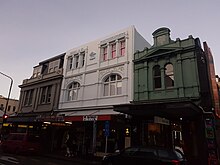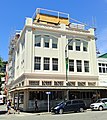
Pedestrian zones are areas of a city or town restricted to use by people on foot or human-powered transport such as bicycles, with non-emergency motor traffic not allowed. Converting a street or an area to pedestrian-only use is called pedestrianisation.

Wellington City Council is a territorial authority in New Zealand, governing the city of Wellington, the country's capital city and third-largest city by population, behind Auckland and Christchurch. It consists of the central historic town and certain additional areas within the Wellington metropolitan area, extending as far north as Linden and covering rural areas such as Mākara and Ohariu. The city adjoins Porirua in the north and Hutt City in the north-east. It is one of nine territorial authorities in the Wellington Region.

Oriental Bay is a bay and suburb of Wellington, the capital city of New Zealand. Known for being both a popular beach and an opulent centre of affluence in the city, it is located close to the central business district on Wellington Harbour.

Brooklyn is a suburb of Wellington, the capital city of New Zealand, under the governance of Wellington City Council. It lies 3 km south of Wellington's central business district on the eastern slopes of the hills above Happy Valley. It is located to the south of Aro Valley and Highbury, west of Mount Cook, north of Vogeltown, Mornington and Ōwhiro Bay and east of Kowhai Park, Panorama Heights, Mitcheltown and Karori.

The Aro Valley forms a small inner-city suburb of Wellington in New Zealand. It takes its name from the stream which originally flowed where modern Hōniana Te Puni Street is. The stream's Māori name was originally Wai-Mapihi, but it was commonly called Te Aro Stream due to it running through the Te Aro flat.
The Freedom Shop is an anarchist infoshop which distributes books and information, based in Wellington, New Zealand. It operates on a non profit basis, injecting any income back into the project. The shop has been based in different locations and mainly sells books on anarchism, feminism, indigenous rights, ecology and a range of activist issues. It also carries patches, badges, clothing and music.
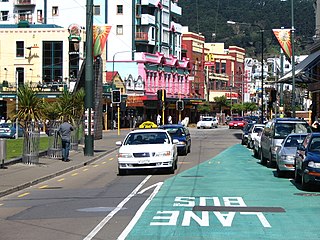
Te Aro is an inner-city suburb of Wellington, New Zealand. It comprises the southern part of the central business district including the majority of the city's entertainment district and covers the mostly flat area of city between The Terrace and Cambridge Terrace at the base of Mount Victoria.

Te Ngākau Civic Square is a public square in central Wellington, New Zealand, between the Wellington central business district to the north and the Te Aro entertainment district to the south. The square is bounded by Jervois Quay, Harris Street, Victoria Street and Wakefield Street

Courtenay Place is the main street of the Courtenay Quarter in the Wellington inner-city district of Te Aro.

Vivian Street is a mostly one-way arterial road in central Wellington, New Zealand. It forms a part of the country's State Highway 1 network.

The Wellington Urban Motorway, part of State HIghway 1, is the main road into and out of Wellington, New Zealand. It is 7 km long, ranges from three to seven lanes wide, and extends from the base of the Ngauranga Gorge into the Wellington CBD.
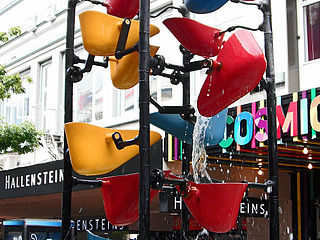
The Bucket Fountain is an iconic kinetic sculpture in Wellington, the capital city of New Zealand. It is located in Cuba Mall, which is part of Cuba Street. It consists of a series of "buckets" that fill with water until they tip, spilling their load into the buckets and pool below. The fountain was designed by Graham Allardice of Burren and Keen and erected in 1969.

The Auckland Central Business District (CBD), or Auckland city centre, is the geographical and economic heart of the Auckland metropolitan area. It is the area in which Auckland was established in 1840, by William Hobson on land gifted by mana whenuahapū Ngāti Whātua Ōrākei. It is New Zealand's leading financial hub, and the centre of the country's economy; the GDP of the Auckland Region was NZD$139 billion in the year ending September 2023.

Sir Edward Michael Coulson Fowler was a New Zealand architect and author who served as mayor of Wellington from 1974 to 1983.

The Wellington Inner City Bypass is a westbound one-way road varying from two to four lanes largely at ground level in central Wellington, New Zealand, part of State Highway 1, and was fully opened in March 2007.

City Mall is the main pedestrian mall in the central city of Christchurch, New Zealand, comprising two sections of Cashel Street plus the Bridge of Remembrance and one section of High Street. It is also known colloquially as Cashel Mall. The Bridge of Remembrance was pedestrianised in 1976. The main mall was closed to traffic on 11 January 1982 and formally reopened as a pedestrian mall on 7 August, but it was not until 1992 that the entire mall was paved. The mall was redeveloped between 2006 and 2009, and track was installed for an expansion of the heritage tram network.

Carmen Rupe, was a New Zealand drag performer, brothel keeper, anti-discrimination activist, would-be politician and HIV/AIDS activist. Carmen Rupe was New Zealand's first drag queen to reach celebrity status. She was a trans woman.

CubaDupa is New Zealand's largest outdoor arts and music festival, celebrating the unique character of Cuba Street, Wellington. CubaDupa describes itself as "a creative playground blurring the lines between audience & performer." It attracts up to 100,000 people. The festival is managed and produced by the non-profit Creative Capital Arts Trust. It is held each year over a weekend in late March. The festival features a dozen music stages, parade groups, street theatre performances, visual art installations, and food and beverage vendors. Some central city streets are closed with Cuba Street in the centre, creating a large pedestrian festival zone. Many artists participate in the CubaDupa programme, including acts from all over the world. In 2023, over 1,200 artists were signed up to perform, in 41 different venues around the city centre.
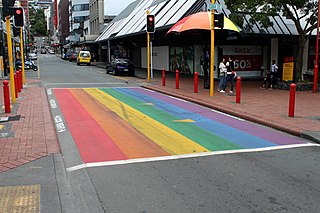
The Cuba Street rainbow crossing is New Zealand's second rainbow pedestrian crossing - the first being made in Queenstown in June 2018.
MartinJames Wilson was an environmentalist and community leader from Wellington, New Zealand. In the 1980s he initiated and ran several Cuba Street Carnivals, started the Birdman competitions on the Wellington waterfront and initiated festivals and craft markets though several suburbs over decades. He raised awareness of food waste via setting up and running guerrilla gardening composting in his local suburb of Aro Valley.
